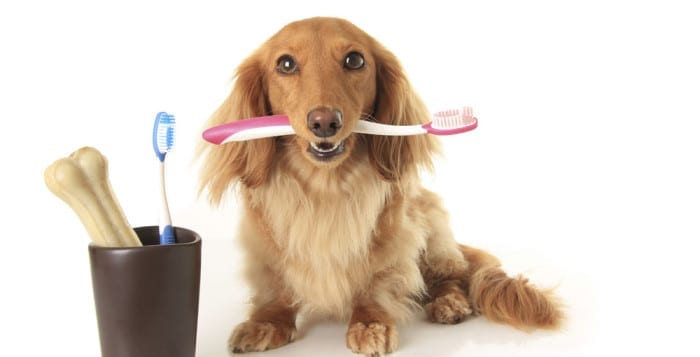Pediatric dental health in pets
By Matthew Kearns, DVM
February is National Pet Dental Health Month and I thought this would be a good time to discuss pediatric dental health in pets. So, how young is too young to start evaluating the teeth? The evaluation actually starts on the first exam.
The first thing we veterinarians look for is occlusion. Occlusion refers to how the teeth contact each other. Proper occlusion is necessary not only for prehension (the chewing process where food is grabbed and brought into the mouth), but also mastication (the chewing process where food is crushed and ground by the teeth). If the teeth on the maxilla (upper portion of the jaw) and mandible (lower portion of the jaw) do not line up properly this not only makes the chewing process more difficult, but also leads to issues with your pet’s teeth later in life.
Why does it lead to problems? Well, just like us humans, dogs and cats plaque on their teeth. Plaque is a thin film of bacteria, saliva, and food will accumulate on the enamel of the tooth within 24 hours of last cleaning. If plaque is not removed it will mineralize within 10 days. (This is called tartar or calculus.)
Once tartar takes hold, a shift develops from aerobic bacteria (bacteria that need oxygen to survive) to nasty anaerobic bacteria (those that need little or no oxygen to survive). These anaerobic bacteria secrete toxins that inflame the gums and lead to small abscesses or pockets under the gums. If left unchecked, these bacteria start to destroy the periodontal ligament and perialveolar bone. This is very painful. I have seen many a pet where I could see that they were chewing on one side of their mouth by the amount of tartar and gingivitis on the other side. I have also had patients that go back to eating hard food after diseased teeth were extracted.
A mouth with normal or appropriate occlusion is like a self-cleaning oven. When your dog or cat is grabbing at food with the more rostral teeth (the teeth closer to the nose) it cleans the incisors, or front teeth, and canines, fang teeth; the friction removes plaque before it can develop into tartar and progress into more advanced periodontal disease. Ideally, the maxilla is slightly longer than the mandible. If the conformation of the jaw does not match this, there are options that can be discussed with your veterinarian.
The second thing we look at is proper eruption. Proper eruption of teeth refers to when the teeth first appear above the gumline. In puppies the deciduous, or temporary teeth, erupt between 4-6 weeks and kittens between 3-4 weeks. Adult teeth erupt in puppies between 4-7 months and, in kittens, between 4-6 months. The eruption of adult teeth triggers the resorption of the deciduous roots causing those teeth to spontaneously fall out. Unfortunately, in some cases that either does not happen in a timely manner, or at all.
Conditions such as delayed eruption, supernumerary (extra) teeth, or persistent deciduous teeth can occur for a variety of reasons but need to be diagnosed and treated early on. If not, these conditions not only lead to pain, but also lead to dental malocclusion and other problems (dental cysts, etc.).
Diagnosis of malocclusion, delayed eruption, and retained deciduous teeth early on (especially in severe cases) opens the discussion to early intervention, a key to preventing disease. So, get your pet to show their teeth (and hopefully not use them on the vet) at your next visit. SMILE!!
Dr. Kearns has been in practice for 16 years.







